Business Decision Making Using Data Analysis: Darling Ingredients Ltd
VerifiedAdded on 2023/06/10
|11
|3293
|338
Report
AI Summary
This report delves into the crucial role of business decision-making, emphasizing the application of data analysis techniques within organizations, particularly Darling Ingredients Limited, a UK-based B2C telemarketing company. It outlines a plan for collecting both primary and secondary data, justifying the chosen survey methodology and sampling frame. The report examines various statistical tools, including cash flow statements and ratio analysis, to analyze collected data and aid the business decision-making process. Furthermore, it presents data through graphs and charts to draw valid conclusions about the business's financial performance and market position, offering recommendations based on the analysis. The report covers data collection sources, such as primary and secondary data, and their utilization by companies. It computes and interprets different types of ratios to assess the company's monetary position and presents data with charts and graphs to facilitate informed decision-making.

Business Decision
Making
Making
Paraphrase This Document
Need a fresh take? Get an instant paraphrase of this document with our AI Paraphraser
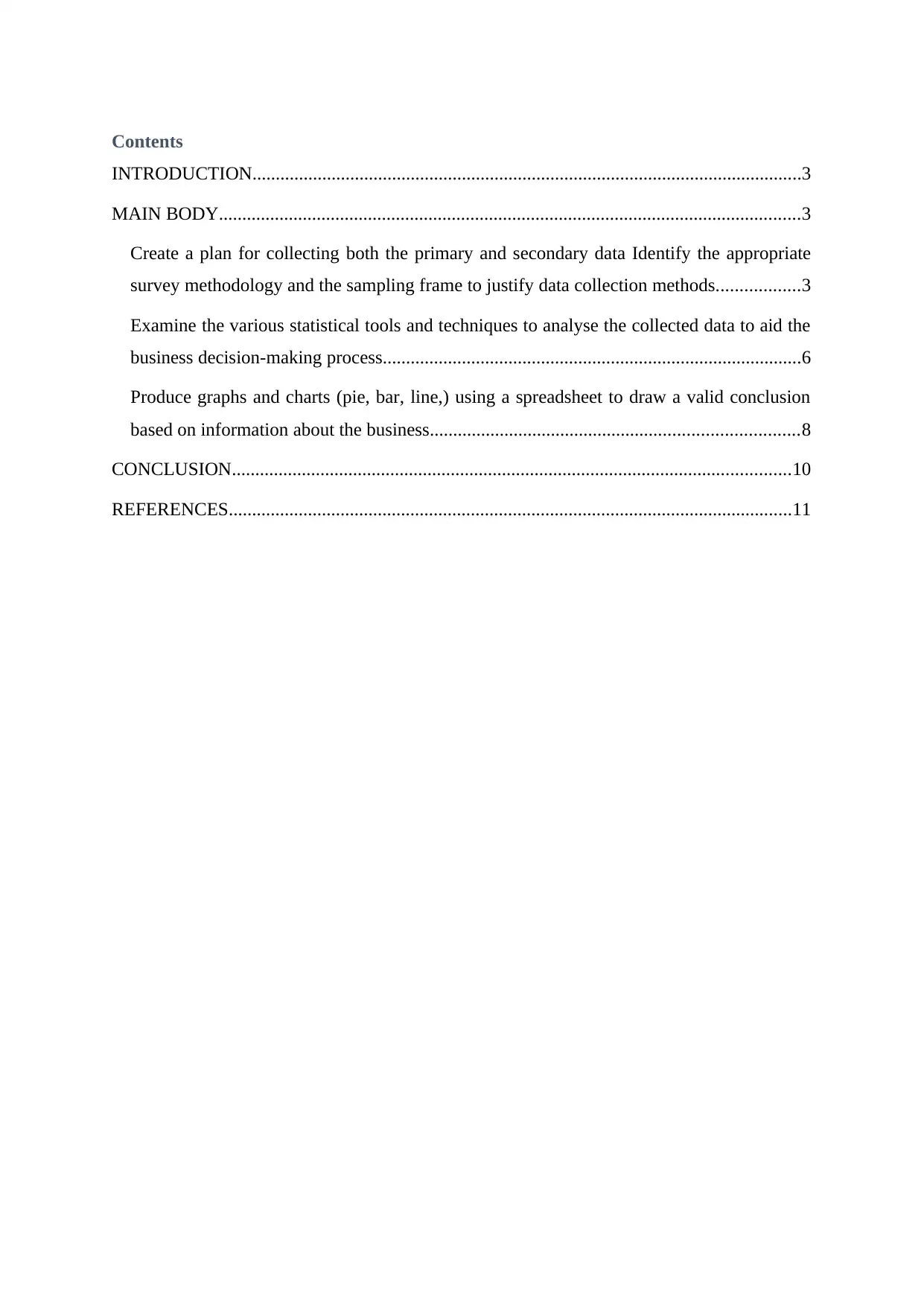
Contents
INTRODUCTION......................................................................................................................3
MAIN BODY.............................................................................................................................3
Create a plan for collecting both the primary and secondary data Identify the appropriate
survey methodology and the sampling frame to justify data collection methods..................3
Examine the various statistical tools and techniques to analyse the collected data to aid the
business decision-making process..........................................................................................6
Produce graphs and charts (pie, bar, line,) using a spreadsheet to draw a valid conclusion
based on information about the business...............................................................................8
CONCLUSION........................................................................................................................10
REFERENCES.........................................................................................................................11
INTRODUCTION......................................................................................................................3
MAIN BODY.............................................................................................................................3
Create a plan for collecting both the primary and secondary data Identify the appropriate
survey methodology and the sampling frame to justify data collection methods..................3
Examine the various statistical tools and techniques to analyse the collected data to aid the
business decision-making process..........................................................................................6
Produce graphs and charts (pie, bar, line,) using a spreadsheet to draw a valid conclusion
based on information about the business...............................................................................8
CONCLUSION........................................................................................................................10
REFERENCES.........................................................................................................................11

INTRODUCTION
Business decision–making helps in taking critical decisions for the welfare and
betterment of the company. It also helps to grow the organisation by opening various
opportunities through qualitative and quantitative analysis (Ambuehl and et.al., 2022). In the
following report, the company is taken is Darling Ingredients Limited which is UK-based and
is a B2C telemarketing company. The following report contains data collecting sources such
as primary and secondary sources, by the identification of it that how the companies use these
sources. Further, through the help of the cash flow statement, an analysis is performed and
different types of ratios are computed and interpreted for knowing about the monetary
position of the company. Also, with the help of charts and graphs, the above data is presented
for driving the conclusion and some recommendations from the report.
MAIN BODY
Create a plan for collecting both the primary and secondary data Identify the appropriate
survey methodology and the sampling frame to justify data collection methods.
Collection of data: Data collection is a medium of collecting data that can be useful for
organisations. It means collecting, measuring and analyzing the information about the various
sources which can be helpful for finding out the answers to each of the problems that the
organisation might face. These are assimilated in structured as well as unstructured forms
There are two sources of data: Primary and Secondary data.
Primary Data: It is a piece of raw and unadulterated information that is gathered by the
analyst. This type of information is the least demanding of the multitude of information. The
researcher of the company accumulates the data through correspondence, association,
overviews, or a few analyses. It occurs uniquely when a specific subject, goods and services
are famous or popular in the market place and furthermore some studies are assumed the
basis of necessity. The company Darling Ingredients Limited is collecting the data for
accumulating about its primary sources and the feedback from the customers so that it can
enhance its business. For this, it must investigate its target markets and the products and
services that the customers will most likely incur. The objective for collecting the data should
clearly be defined and the identification of the customers should also be known (Arora and
Chakraborty, 2021). There are following strategies for essential information sources are:
Interviews: It is the instrument of essential information which perform between at
least two groups of people. In this technique two sorts of people groups are
Business decision–making helps in taking critical decisions for the welfare and
betterment of the company. It also helps to grow the organisation by opening various
opportunities through qualitative and quantitative analysis (Ambuehl and et.al., 2022). In the
following report, the company is taken is Darling Ingredients Limited which is UK-based and
is a B2C telemarketing company. The following report contains data collecting sources such
as primary and secondary sources, by the identification of it that how the companies use these
sources. Further, through the help of the cash flow statement, an analysis is performed and
different types of ratios are computed and interpreted for knowing about the monetary
position of the company. Also, with the help of charts and graphs, the above data is presented
for driving the conclusion and some recommendations from the report.
MAIN BODY
Create a plan for collecting both the primary and secondary data Identify the appropriate
survey methodology and the sampling frame to justify data collection methods.
Collection of data: Data collection is a medium of collecting data that can be useful for
organisations. It means collecting, measuring and analyzing the information about the various
sources which can be helpful for finding out the answers to each of the problems that the
organisation might face. These are assimilated in structured as well as unstructured forms
There are two sources of data: Primary and Secondary data.
Primary Data: It is a piece of raw and unadulterated information that is gathered by the
analyst. This type of information is the least demanding of the multitude of information. The
researcher of the company accumulates the data through correspondence, association,
overviews, or a few analyses. It occurs uniquely when a specific subject, goods and services
are famous or popular in the market place and furthermore some studies are assumed the
basis of necessity. The company Darling Ingredients Limited is collecting the data for
accumulating about its primary sources and the feedback from the customers so that it can
enhance its business. For this, it must investigate its target markets and the products and
services that the customers will most likely incur. The objective for collecting the data should
clearly be defined and the identification of the customers should also be known (Arora and
Chakraborty, 2021). There are following strategies for essential information sources are:
Interviews: It is the instrument of essential information which perform between at
least two groups of people. In this technique two sorts of people groups are
⊘ This is a preview!⊘
Do you want full access?
Subscribe today to unlock all pages.

Trusted by 1+ million students worldwide

accumulated, one is for addressing and the other one is for responding to the inquiries.
This apparatus is performed in 2 different ways, vital interviews and face-to-face
interviews.
Assessments and Questionnaires: It is done after giving the essential reactions, the
specialist needs to record and disregard them. It is proper to direct a pioneer to
concentrate on where the inquiries are filled by experienced and furthermore need to
investigate the strategies which are not sufficient.
Secondary Data: Optional information is gathered from different sources which as of now
have gathered information as per their need for exploration. The information is sifted by the
need for the examination and shortlisted from currently gathered sources. Information might
be gathered from the interior sources which have early gathered for exploration reason. Outer
sources are those sources that are outside the association and information is gathered from
those sources as indicated by the need of the examination (Balasubramnian and Sargent,
2020). Inward sources further incorporate:
Balance sheet
Profit and Loss statement
Sales Figure
Previous marketing studies
Inventory records
In the event that the information gathered won't be sufficient to lead an examination, then, at
that point, the information can be gathered from outside sources which incorporate:
Universities
Corporate filings
Business, trade, and professional association
Government sources
Types of secondary data:
Websites: It is a sort of auxiliary data through which information can be gathered, for
example, locales created by the organization for better availability through clients.
Sites assists with getting information that would give valuable insights regarding
business like its benefit and misfortune explanations and records, monetary place of a
connected firm in the economy regardless of whether client commitment has
expanded. It likewise gives information about forthcoming proposals of the firm over
years (Chen, 2018).
This apparatus is performed in 2 different ways, vital interviews and face-to-face
interviews.
Assessments and Questionnaires: It is done after giving the essential reactions, the
specialist needs to record and disregard them. It is proper to direct a pioneer to
concentrate on where the inquiries are filled by experienced and furthermore need to
investigate the strategies which are not sufficient.
Secondary Data: Optional information is gathered from different sources which as of now
have gathered information as per their need for exploration. The information is sifted by the
need for the examination and shortlisted from currently gathered sources. Information might
be gathered from the interior sources which have early gathered for exploration reason. Outer
sources are those sources that are outside the association and information is gathered from
those sources as indicated by the need of the examination (Balasubramnian and Sargent,
2020). Inward sources further incorporate:
Balance sheet
Profit and Loss statement
Sales Figure
Previous marketing studies
Inventory records
In the event that the information gathered won't be sufficient to lead an examination, then, at
that point, the information can be gathered from outside sources which incorporate:
Universities
Corporate filings
Business, trade, and professional association
Government sources
Types of secondary data:
Websites: It is a sort of auxiliary data through which information can be gathered, for
example, locales created by the organization for better availability through clients.
Sites assists with getting information that would give valuable insights regarding
business like its benefit and misfortune explanations and records, monetary place of a
connected firm in the economy regardless of whether client commitment has
expanded. It likewise gives information about forthcoming proposals of the firm over
years (Chen, 2018).
Paraphrase This Document
Need a fresh take? Get an instant paraphrase of this document with our AI Paraphraser
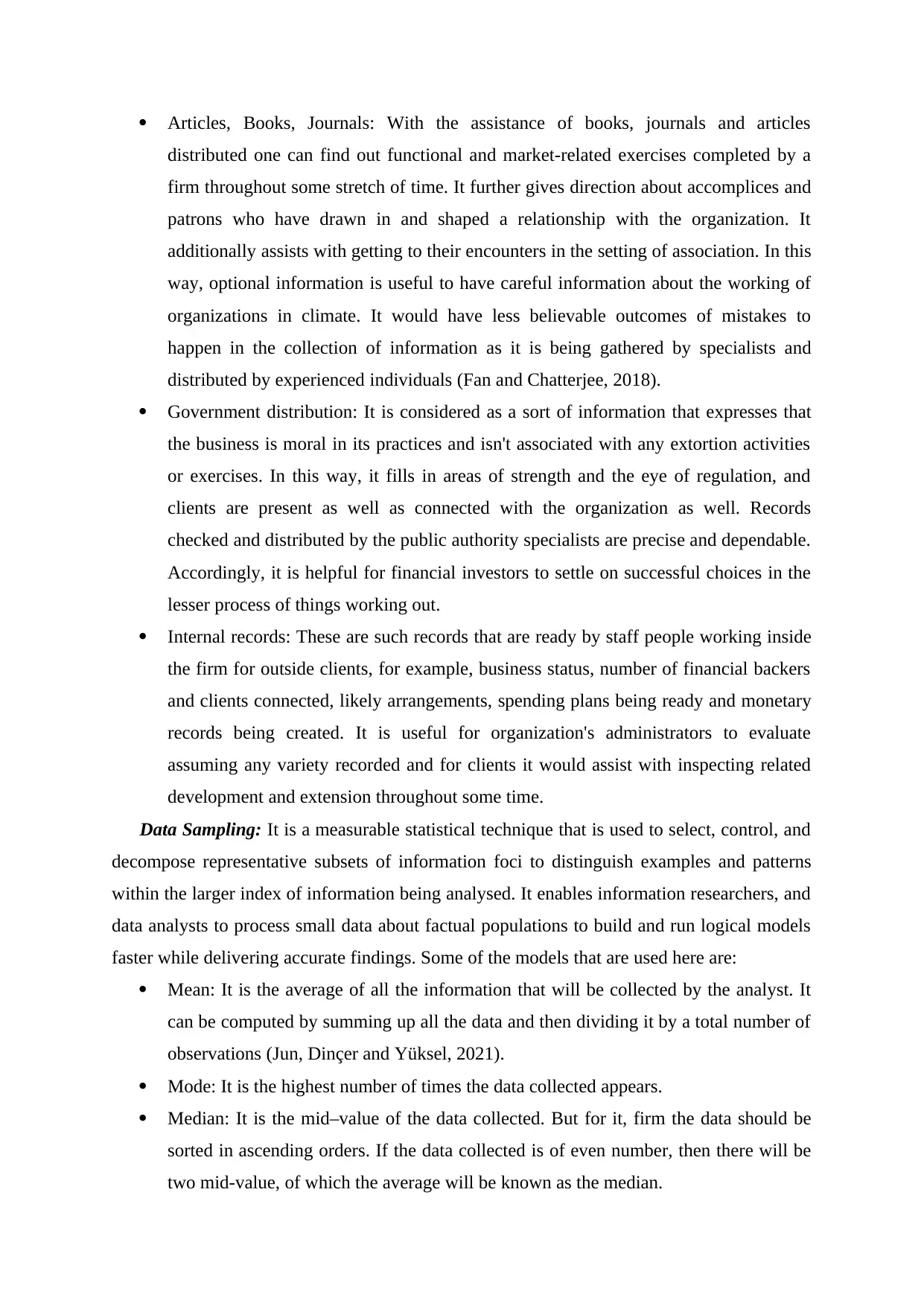
Articles, Books, Journals: With the assistance of books, journals and articles
distributed one can find out functional and market-related exercises completed by a
firm throughout some stretch of time. It further gives direction about accomplices and
patrons who have drawn in and shaped a relationship with the organization. It
additionally assists with getting to their encounters in the setting of association. In this
way, optional information is useful to have careful information about the working of
organizations in climate. It would have less believable outcomes of mistakes to
happen in the collection of information as it is being gathered by specialists and
distributed by experienced individuals (Fan and Chatterjee, 2018).
Government distribution: It is considered as a sort of information that expresses that
the business is moral in its practices and isn't associated with any extortion activities
or exercises. In this way, it fills in areas of strength and the eye of regulation, and
clients are present as well as connected with the organization as well. Records
checked and distributed by the public authority specialists are precise and dependable.
Accordingly, it is helpful for financial investors to settle on successful choices in the
lesser process of things working out.
Internal records: These are such records that are ready by staff people working inside
the firm for outside clients, for example, business status, number of financial backers
and clients connected, likely arrangements, spending plans being ready and monetary
records being created. It is useful for organization's administrators to evaluate
assuming any variety recorded and for clients it would assist with inspecting related
development and extension throughout some time.
Data Sampling: It is a measurable statistical technique that is used to select, control, and
decompose representative subsets of information foci to distinguish examples and patterns
within the larger index of information being analysed. It enables information researchers, and
data analysts to process small data about factual populations to build and run logical models
faster while delivering accurate findings. Some of the models that are used here are:
Mean: It is the average of all the information that will be collected by the analyst. It
can be computed by summing up all the data and then dividing it by a total number of
observations (Jun, Dinçer and Yüksel, 2021).
Mode: It is the highest number of times the data collected appears.
Median: It is the mid–value of the data collected. But for it, firm the data should be
sorted in ascending orders. If the data collected is of even number, then there will be
two mid-value, of which the average will be known as the median.
distributed one can find out functional and market-related exercises completed by a
firm throughout some stretch of time. It further gives direction about accomplices and
patrons who have drawn in and shaped a relationship with the organization. It
additionally assists with getting to their encounters in the setting of association. In this
way, optional information is useful to have careful information about the working of
organizations in climate. It would have less believable outcomes of mistakes to
happen in the collection of information as it is being gathered by specialists and
distributed by experienced individuals (Fan and Chatterjee, 2018).
Government distribution: It is considered as a sort of information that expresses that
the business is moral in its practices and isn't associated with any extortion activities
or exercises. In this way, it fills in areas of strength and the eye of regulation, and
clients are present as well as connected with the organization as well. Records
checked and distributed by the public authority specialists are precise and dependable.
Accordingly, it is helpful for financial investors to settle on successful choices in the
lesser process of things working out.
Internal records: These are such records that are ready by staff people working inside
the firm for outside clients, for example, business status, number of financial backers
and clients connected, likely arrangements, spending plans being ready and monetary
records being created. It is useful for organization's administrators to evaluate
assuming any variety recorded and for clients it would assist with inspecting related
development and extension throughout some time.
Data Sampling: It is a measurable statistical technique that is used to select, control, and
decompose representative subsets of information foci to distinguish examples and patterns
within the larger index of information being analysed. It enables information researchers, and
data analysts to process small data about factual populations to build and run logical models
faster while delivering accurate findings. Some of the models that are used here are:
Mean: It is the average of all the information that will be collected by the analyst. It
can be computed by summing up all the data and then dividing it by a total number of
observations (Jun, Dinçer and Yüksel, 2021).
Mode: It is the highest number of times the data collected appears.
Median: It is the mid–value of the data collected. But for it, firm the data should be
sorted in ascending orders. If the data collected is of even number, then there will be
two mid-value, of which the average will be known as the median.
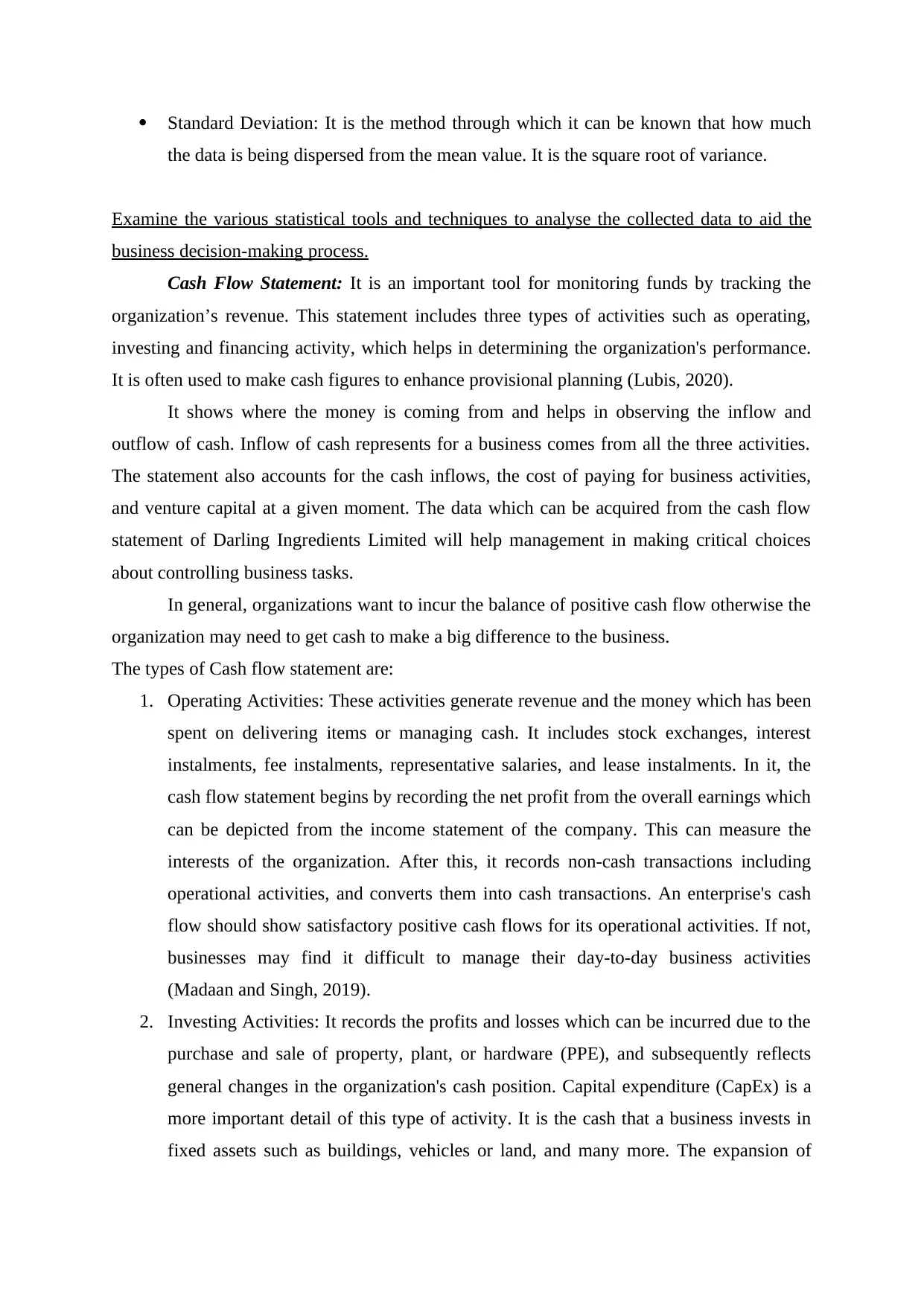
Standard Deviation: It is the method through which it can be known that how much
the data is being dispersed from the mean value. It is the square root of variance.
Examine the various statistical tools and techniques to analyse the collected data to aid the
business decision-making process.
Cash Flow Statement: It is an important tool for monitoring funds by tracking the
organization’s revenue. This statement includes three types of activities such as operating,
investing and financing activity, which helps in determining the organization's performance.
It is often used to make cash figures to enhance provisional planning (Lubis, 2020).
It shows where the money is coming from and helps in observing the inflow and
outflow of cash. Inflow of cash represents for a business comes from all the three activities.
The statement also accounts for the cash inflows, the cost of paying for business activities,
and venture capital at a given moment. The data which can be acquired from the cash flow
statement of Darling Ingredients Limited will help management in making critical choices
about controlling business tasks.
In general, organizations want to incur the balance of positive cash flow otherwise the
organization may need to get cash to make a big difference to the business.
The types of Cash flow statement are:
1. Operating Activities: These activities generate revenue and the money which has been
spent on delivering items or managing cash. It includes stock exchanges, interest
instalments, fee instalments, representative salaries, and lease instalments. In it, the
cash flow statement begins by recording the net profit from the overall earnings which
can be depicted from the income statement of the company. This can measure the
interests of the organization. After this, it records non-cash transactions including
operational activities, and converts them into cash transactions. An enterprise's cash
flow should show satisfactory positive cash flows for its operational activities. If not,
businesses may find it difficult to manage their day-to-day business activities
(Madaan and Singh, 2019).
2. Investing Activities: It records the profits and losses which can be incurred due to the
purchase and sale of property, plant, or hardware (PPE), and subsequently reflects
general changes in the organization's cash position. Capital expenditure (CapEx) is a
more important detail of this type of activity. It is the cash that a business invests in
fixed assets such as buildings, vehicles or land, and many more. The expansion of
the data is being dispersed from the mean value. It is the square root of variance.
Examine the various statistical tools and techniques to analyse the collected data to aid the
business decision-making process.
Cash Flow Statement: It is an important tool for monitoring funds by tracking the
organization’s revenue. This statement includes three types of activities such as operating,
investing and financing activity, which helps in determining the organization's performance.
It is often used to make cash figures to enhance provisional planning (Lubis, 2020).
It shows where the money is coming from and helps in observing the inflow and
outflow of cash. Inflow of cash represents for a business comes from all the three activities.
The statement also accounts for the cash inflows, the cost of paying for business activities,
and venture capital at a given moment. The data which can be acquired from the cash flow
statement of Darling Ingredients Limited will help management in making critical choices
about controlling business tasks.
In general, organizations want to incur the balance of positive cash flow otherwise the
organization may need to get cash to make a big difference to the business.
The types of Cash flow statement are:
1. Operating Activities: These activities generate revenue and the money which has been
spent on delivering items or managing cash. It includes stock exchanges, interest
instalments, fee instalments, representative salaries, and lease instalments. In it, the
cash flow statement begins by recording the net profit from the overall earnings which
can be depicted from the income statement of the company. This can measure the
interests of the organization. After this, it records non-cash transactions including
operational activities, and converts them into cash transactions. An enterprise's cash
flow should show satisfactory positive cash flows for its operational activities. If not,
businesses may find it difficult to manage their day-to-day business activities
(Madaan and Singh, 2019).
2. Investing Activities: It records the profits and losses which can be incurred due to the
purchase and sale of property, plant, or hardware (PPE), and subsequently reflects
general changes in the organization's cash position. Capital expenditure (CapEx) is a
more important detail of this type of activity. It is the cash that a business invests in
fixed assets such as buildings, vehicles or land, and many more. The expansion of
⊘ This is a preview!⊘
Do you want full access?
Subscribe today to unlock all pages.

Trusted by 1+ million students worldwide
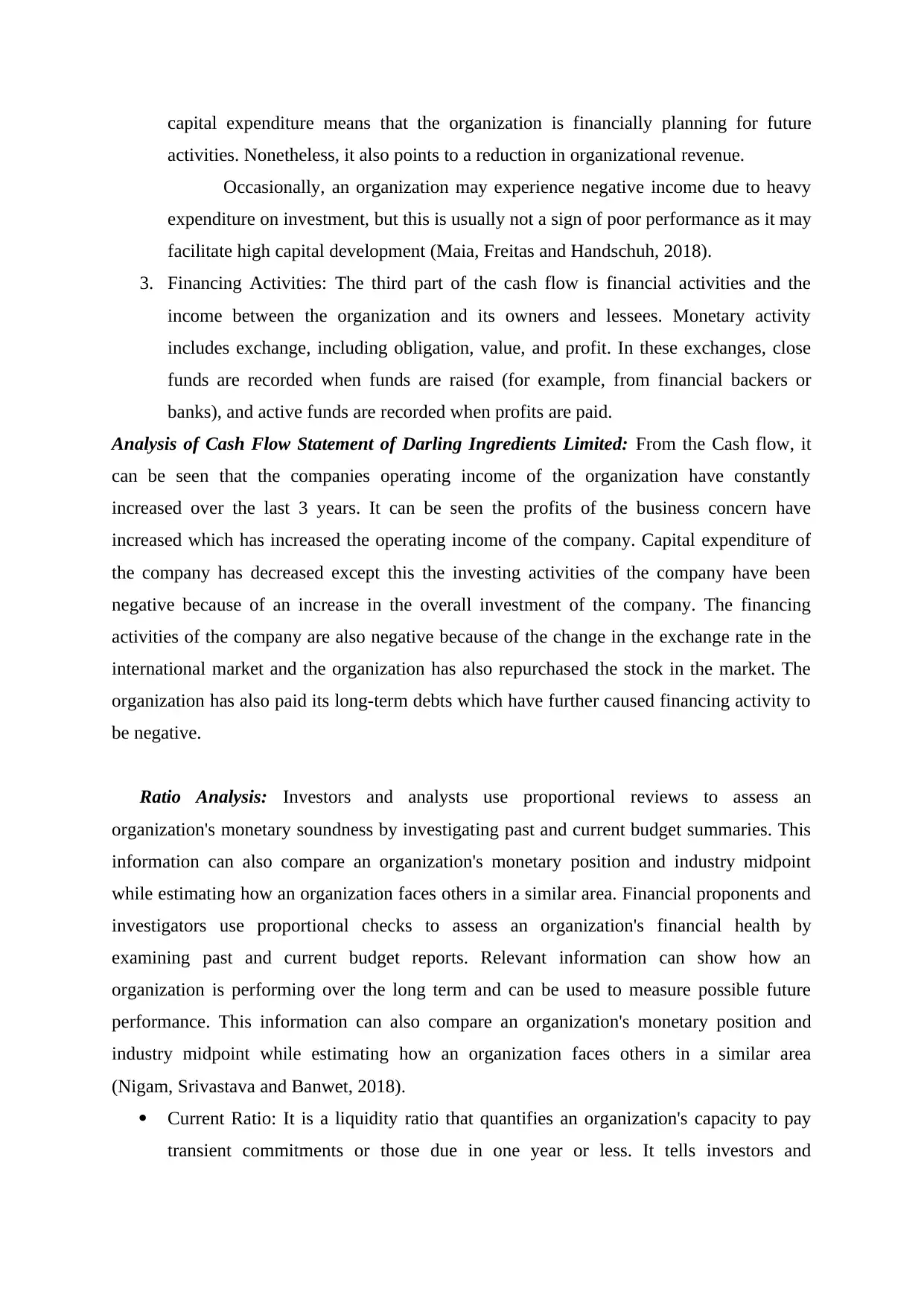
capital expenditure means that the organization is financially planning for future
activities. Nonetheless, it also points to a reduction in organizational revenue.
Occasionally, an organization may experience negative income due to heavy
expenditure on investment, but this is usually not a sign of poor performance as it may
facilitate high capital development (Maia, Freitas and Handschuh, 2018).
3. Financing Activities: The third part of the cash flow is financial activities and the
income between the organization and its owners and lessees. Monetary activity
includes exchange, including obligation, value, and profit. In these exchanges, close
funds are recorded when funds are raised (for example, from financial backers or
banks), and active funds are recorded when profits are paid.
Analysis of Cash Flow Statement of Darling Ingredients Limited: From the Cash flow, it
can be seen that the companies operating income of the organization have constantly
increased over the last 3 years. It can be seen the profits of the business concern have
increased which has increased the operating income of the company. Capital expenditure of
the company has decreased except this the investing activities of the company have been
negative because of an increase in the overall investment of the company. The financing
activities of the company are also negative because of the change in the exchange rate in the
international market and the organization has also repurchased the stock in the market. The
organization has also paid its long-term debts which have further caused financing activity to
be negative.
Ratio Analysis: Investors and analysts use proportional reviews to assess an
organization's monetary soundness by investigating past and current budget summaries. This
information can also compare an organization's monetary position and industry midpoint
while estimating how an organization faces others in a similar area. Financial proponents and
investigators use proportional checks to assess an organization's financial health by
examining past and current budget reports. Relevant information can show how an
organization is performing over the long term and can be used to measure possible future
performance. This information can also compare an organization's monetary position and
industry midpoint while estimating how an organization faces others in a similar area
(Nigam, Srivastava and Banwet, 2018).
Current Ratio: It is a liquidity ratio that quantifies an organization's capacity to pay
transient commitments or those due in one year or less. It tells investors and
activities. Nonetheless, it also points to a reduction in organizational revenue.
Occasionally, an organization may experience negative income due to heavy
expenditure on investment, but this is usually not a sign of poor performance as it may
facilitate high capital development (Maia, Freitas and Handschuh, 2018).
3. Financing Activities: The third part of the cash flow is financial activities and the
income between the organization and its owners and lessees. Monetary activity
includes exchange, including obligation, value, and profit. In these exchanges, close
funds are recorded when funds are raised (for example, from financial backers or
banks), and active funds are recorded when profits are paid.
Analysis of Cash Flow Statement of Darling Ingredients Limited: From the Cash flow, it
can be seen that the companies operating income of the organization have constantly
increased over the last 3 years. It can be seen the profits of the business concern have
increased which has increased the operating income of the company. Capital expenditure of
the company has decreased except this the investing activities of the company have been
negative because of an increase in the overall investment of the company. The financing
activities of the company are also negative because of the change in the exchange rate in the
international market and the organization has also repurchased the stock in the market. The
organization has also paid its long-term debts which have further caused financing activity to
be negative.
Ratio Analysis: Investors and analysts use proportional reviews to assess an
organization's monetary soundness by investigating past and current budget summaries. This
information can also compare an organization's monetary position and industry midpoint
while estimating how an organization faces others in a similar area. Financial proponents and
investigators use proportional checks to assess an organization's financial health by
examining past and current budget reports. Relevant information can show how an
organization is performing over the long term and can be used to measure possible future
performance. This information can also compare an organization's monetary position and
industry midpoint while estimating how an organization faces others in a similar area
(Nigam, Srivastava and Banwet, 2018).
Current Ratio: It is a liquidity ratio that quantifies an organization's capacity to pay
transient commitments or those due in one year or less. It tells investors and
Paraphrase This Document
Need a fresh take? Get an instant paraphrase of this document with our AI Paraphraser
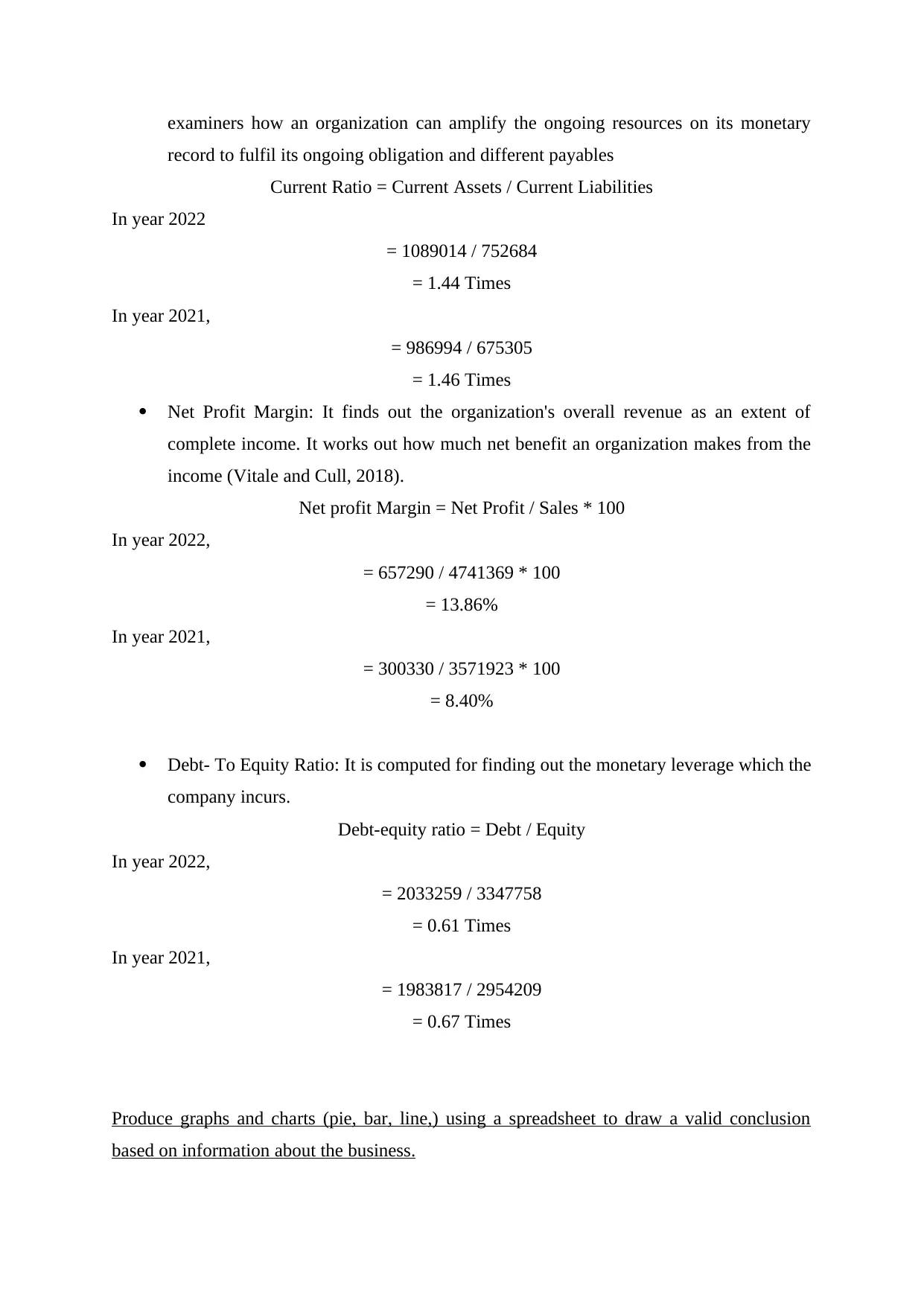
examiners how an organization can amplify the ongoing resources on its monetary
record to fulfil its ongoing obligation and different payables
Current Ratio = Current Assets / Current Liabilities
In year 2022
= 1089014 / 752684
= 1.44 Times
In year 2021,
= 986994 / 675305
= 1.46 Times
Net Profit Margin: It finds out the organization's overall revenue as an extent of
complete income. It works out how much net benefit an organization makes from the
income (Vitale and Cull, 2018).
Net profit Margin = Net Profit / Sales * 100
In year 2022,
= 657290 / 4741369 * 100
= 13.86%
In year 2021,
= 300330 / 3571923 * 100
= 8.40%
Debt- To Equity Ratio: It is computed for finding out the monetary leverage which the
company incurs.
Debt-equity ratio = Debt / Equity
In year 2022,
= 2033259 / 3347758
= 0.61 Times
In year 2021,
= 1983817 / 2954209
= 0.67 Times
Produce graphs and charts (pie, bar, line,) using a spreadsheet to draw a valid conclusion
based on information about the business.
record to fulfil its ongoing obligation and different payables
Current Ratio = Current Assets / Current Liabilities
In year 2022
= 1089014 / 752684
= 1.44 Times
In year 2021,
= 986994 / 675305
= 1.46 Times
Net Profit Margin: It finds out the organization's overall revenue as an extent of
complete income. It works out how much net benefit an organization makes from the
income (Vitale and Cull, 2018).
Net profit Margin = Net Profit / Sales * 100
In year 2022,
= 657290 / 4741369 * 100
= 13.86%
In year 2021,
= 300330 / 3571923 * 100
= 8.40%
Debt- To Equity Ratio: It is computed for finding out the monetary leverage which the
company incurs.
Debt-equity ratio = Debt / Equity
In year 2022,
= 2033259 / 3347758
= 0.61 Times
In year 2021,
= 1983817 / 2954209
= 0.67 Times
Produce graphs and charts (pie, bar, line,) using a spreadsheet to draw a valid conclusion
based on information about the business.
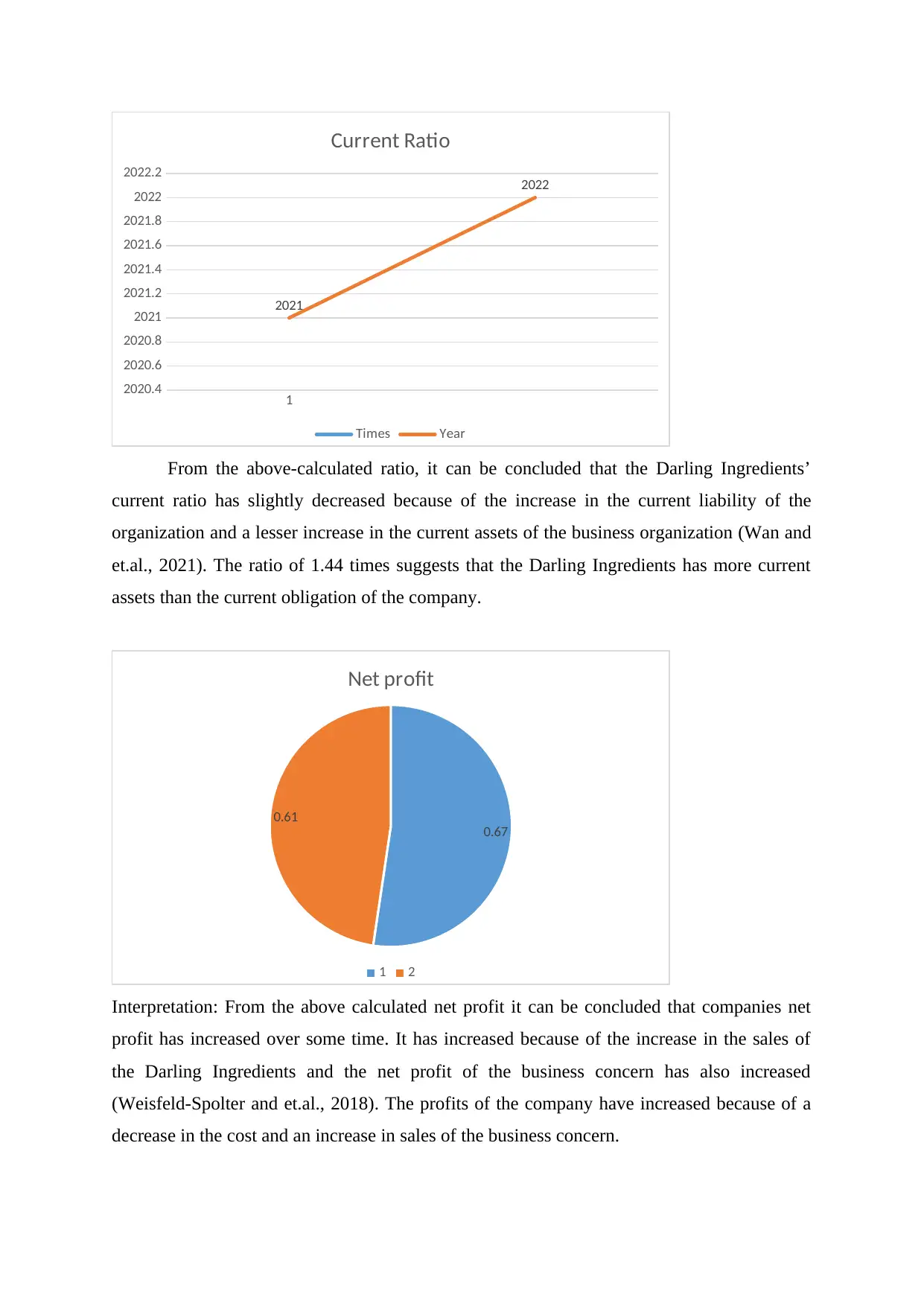
1
2020.4
2020.6
2020.8
2021
2021.2
2021.4
2021.6
2021.8
2022
2022.2
2021
2022
Current Ratio
Times Year
From the above-calculated ratio, it can be concluded that the Darling Ingredients’
current ratio has slightly decreased because of the increase in the current liability of the
organization and a lesser increase in the current assets of the business organization (Wan and
et.al., 2021). The ratio of 1.44 times suggests that the Darling Ingredients has more current
assets than the current obligation of the company.
0.67
0.61
Net profit
1 2
Interpretation: From the above calculated net profit it can be concluded that companies net
profit has increased over some time. It has increased because of the increase in the sales of
the Darling Ingredients and the net profit of the business concern has also increased
(Weisfeld-Spolter and et.al., 2018). The profits of the company have increased because of a
decrease in the cost and an increase in sales of the business concern.
2020.4
2020.6
2020.8
2021
2021.2
2021.4
2021.6
2021.8
2022
2022.2
2021
2022
Current Ratio
Times Year
From the above-calculated ratio, it can be concluded that the Darling Ingredients’
current ratio has slightly decreased because of the increase in the current liability of the
organization and a lesser increase in the current assets of the business organization (Wan and
et.al., 2021). The ratio of 1.44 times suggests that the Darling Ingredients has more current
assets than the current obligation of the company.
0.67
0.61
Net profit
1 2
Interpretation: From the above calculated net profit it can be concluded that companies net
profit has increased over some time. It has increased because of the increase in the sales of
the Darling Ingredients and the net profit of the business concern has also increased
(Weisfeld-Spolter and et.al., 2018). The profits of the company have increased because of a
decrease in the cost and an increase in sales of the business concern.
⊘ This is a preview!⊘
Do you want full access?
Subscribe today to unlock all pages.

Trusted by 1+ million students worldwide
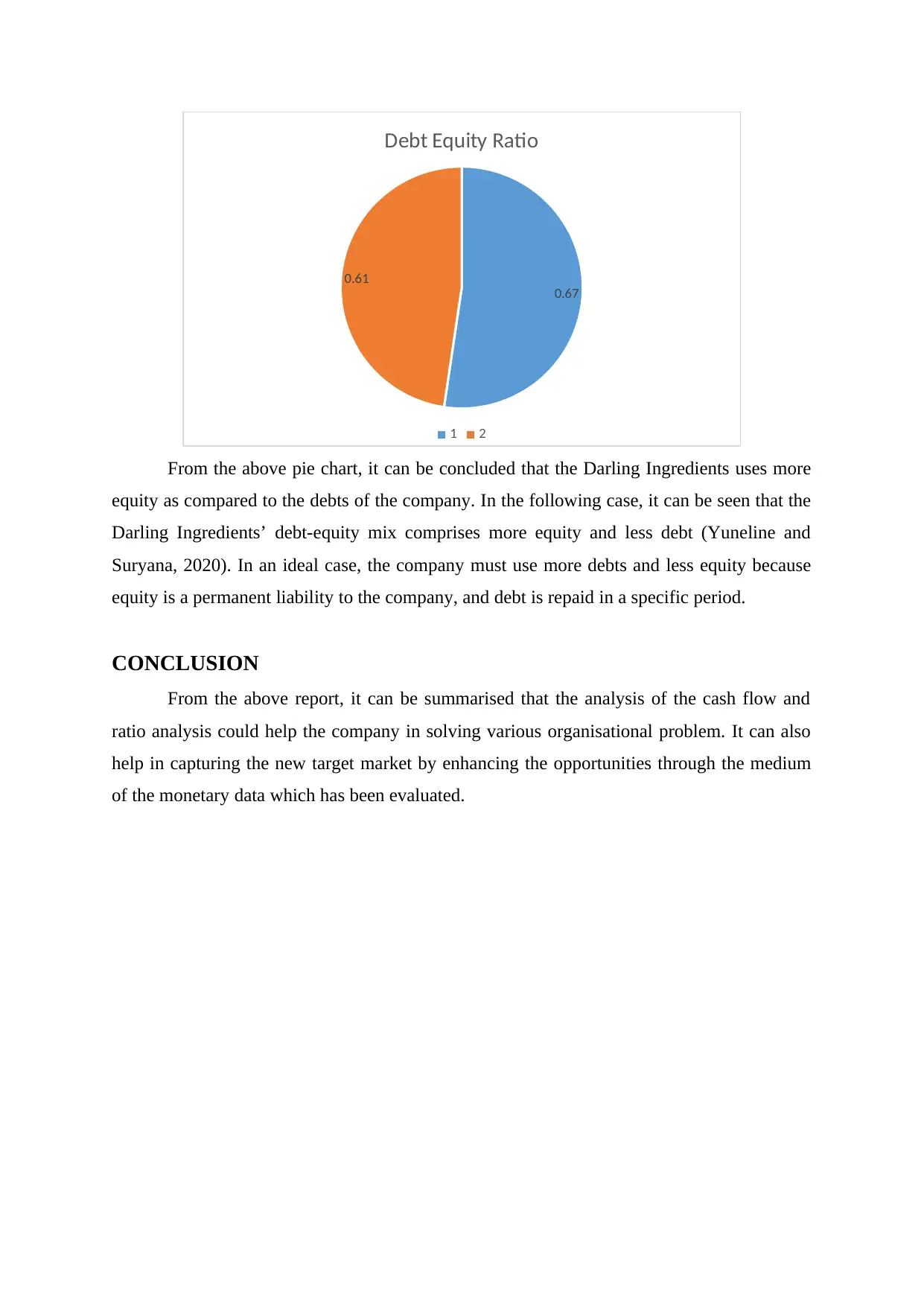
0.67
0.61
Debt Equity Ratio
1 2
From the above pie chart, it can be concluded that the Darling Ingredients uses more
equity as compared to the debts of the company. In the following case, it can be seen that the
Darling Ingredients’ debt-equity mix comprises more equity and less debt (Yuneline and
Suryana, 2020). In an ideal case, the company must use more debts and less equity because
equity is a permanent liability to the company, and debt is repaid in a specific period.
CONCLUSION
From the above report, it can be summarised that the analysis of the cash flow and
ratio analysis could help the company in solving various organisational problem. It can also
help in capturing the new target market by enhancing the opportunities through the medium
of the monetary data which has been evaluated.
0.61
Debt Equity Ratio
1 2
From the above pie chart, it can be concluded that the Darling Ingredients uses more
equity as compared to the debts of the company. In the following case, it can be seen that the
Darling Ingredients’ debt-equity mix comprises more equity and less debt (Yuneline and
Suryana, 2020). In an ideal case, the company must use more debts and less equity because
equity is a permanent liability to the company, and debt is repaid in a specific period.
CONCLUSION
From the above report, it can be summarised that the analysis of the cash flow and
ratio analysis could help the company in solving various organisational problem. It can also
help in capturing the new target market by enhancing the opportunities through the medium
of the monetary data which has been evaluated.
Paraphrase This Document
Need a fresh take? Get an instant paraphrase of this document with our AI Paraphraser

REFERENCES
Books and Journals
Ambuehl, S and et.al., 2022. Social Transmission of Financial Decision Making Skills. A
case of the blind leading the blind?. A Case of the Blind Leading the Blind.
Arora, J. and Chakraborty, M., 2021. Does the ease of reading of financial disclosures
influence investment decision?. Economics Letters, 204, p.109883.
Balasubramnian, B. and Sargent, C.S., 2020. Impact of inflated perceptions of financial
literacy on financial decision making. Journal of Economic Psychology, 80,
p.102306.
Chen, T.Y., 2018. An outranking approach using a risk attitudinal assignment model
involving Pythagorean fuzzy information and its application to financial decision
making. Applied soft computing, 71, pp.460-487.
Fan, L. and Chatterjee, S., 2018. Application of situational stimuli for examining the
effectiveness of financial education: A behavioral finance perspective. Journal of
Behavioral and Experimental Finance, 17, pp.68-75.
Jun, Q., Dinçer, H. and Yüksel, S., 2021. Stochastic hybrid decision‐making based on interval
type 2 fuzzy sets for measuring the innovation capacities of financial
institutions. International Journal of Finance & Economics, 26(1), pp.573-593.
Lubis, A.W., 2020. Skills and household financial decision-making in
Indonesia. International Journal of Social Economics.
Madaan, G. and Singh, S., 2019. An analysis of behavioral biases in investment decision-
making. International Journal of Financial Research, 10(4), pp.55-67.
Maia, M., Freitas, A. and Handschuh, S., 2018, January. Finsslx: A sentiment analysis model
for the financial domain using text simplification. In 2018 IEEE 12th International
Conference on Semantic Computing (ICSC) (pp. 318-319). IEEE.
Nigam, R.M., Srivastava, S. and Banwet, D.K., 2018. Behavioral mediators of financial
decision making–a state-of-art literature review. Review of Behavioral Finance.
Vitale, C. and Cull, M., 2018. Modelling the influence of CEO values and leadership styles
on financial decision making. The Journal of New Business Ideas & Trends, 16(1),
pp.16-30.
Wan, C and et.al., 2021. Treatment decision making and financial toxicity in women with
metastatic breast cancer. Clinical Breast Cancer, 21(1), pp.37-46.
Weisfeld-Spolter, S and et.al., 2018. Integrating affect, cognition, and culture in Hispanic
financial planning. International Journal of Bank Marketing.
Yuneline, M.H. and Suryana, U., 2020. Financial Literacy and its Impact on Funding
Source’s Decision-Making. International Journal of Applied Economics, Finance
and Accounting, 6(1), pp.1-10.
Books and Journals
Ambuehl, S and et.al., 2022. Social Transmission of Financial Decision Making Skills. A
case of the blind leading the blind?. A Case of the Blind Leading the Blind.
Arora, J. and Chakraborty, M., 2021. Does the ease of reading of financial disclosures
influence investment decision?. Economics Letters, 204, p.109883.
Balasubramnian, B. and Sargent, C.S., 2020. Impact of inflated perceptions of financial
literacy on financial decision making. Journal of Economic Psychology, 80,
p.102306.
Chen, T.Y., 2018. An outranking approach using a risk attitudinal assignment model
involving Pythagorean fuzzy information and its application to financial decision
making. Applied soft computing, 71, pp.460-487.
Fan, L. and Chatterjee, S., 2018. Application of situational stimuli for examining the
effectiveness of financial education: A behavioral finance perspective. Journal of
Behavioral and Experimental Finance, 17, pp.68-75.
Jun, Q., Dinçer, H. and Yüksel, S., 2021. Stochastic hybrid decision‐making based on interval
type 2 fuzzy sets for measuring the innovation capacities of financial
institutions. International Journal of Finance & Economics, 26(1), pp.573-593.
Lubis, A.W., 2020. Skills and household financial decision-making in
Indonesia. International Journal of Social Economics.
Madaan, G. and Singh, S., 2019. An analysis of behavioral biases in investment decision-
making. International Journal of Financial Research, 10(4), pp.55-67.
Maia, M., Freitas, A. and Handschuh, S., 2018, January. Finsslx: A sentiment analysis model
for the financial domain using text simplification. In 2018 IEEE 12th International
Conference on Semantic Computing (ICSC) (pp. 318-319). IEEE.
Nigam, R.M., Srivastava, S. and Banwet, D.K., 2018. Behavioral mediators of financial
decision making–a state-of-art literature review. Review of Behavioral Finance.
Vitale, C. and Cull, M., 2018. Modelling the influence of CEO values and leadership styles
on financial decision making. The Journal of New Business Ideas & Trends, 16(1),
pp.16-30.
Wan, C and et.al., 2021. Treatment decision making and financial toxicity in women with
metastatic breast cancer. Clinical Breast Cancer, 21(1), pp.37-46.
Weisfeld-Spolter, S and et.al., 2018. Integrating affect, cognition, and culture in Hispanic
financial planning. International Journal of Bank Marketing.
Yuneline, M.H. and Suryana, U., 2020. Financial Literacy and its Impact on Funding
Source’s Decision-Making. International Journal of Applied Economics, Finance
and Accounting, 6(1), pp.1-10.
1 out of 11
Related Documents
Your All-in-One AI-Powered Toolkit for Academic Success.
+13062052269
info@desklib.com
Available 24*7 on WhatsApp / Email
![[object Object]](/_next/static/media/star-bottom.7253800d.svg)
Unlock your academic potential
Copyright © 2020–2025 A2Z Services. All Rights Reserved. Developed and managed by ZUCOL.





